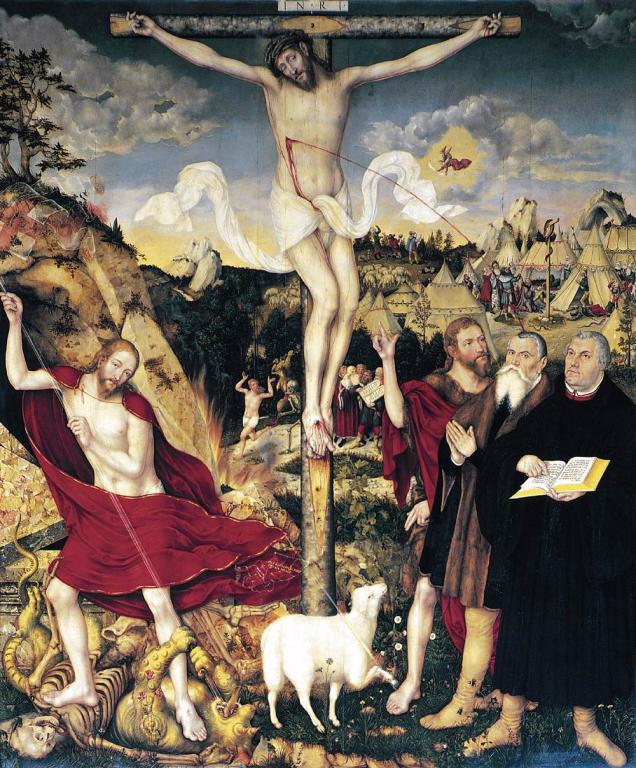Lutherans have confessed the Christology of the Chalcedonian Council, that the two natures of Christ, the divine and human, are “inseparably enjoined in one Person” (AC III 1). Henry Eyster Jacobs summarizes the Personal Union of Christ according to Chalcedon (A Summary of the Christian Faith, 11, Q31) as follows:
- Unconfused: There is no mingling of the natures, but both remain distinct
- Unchanged: One is not changed into another
- Indivisible (with respect to place)
- Inseparable (with respect to time)
Over the controversy that first arose with the Sacramentarians on the Eucharist, Lutherans have gone on further to elucidate how the divine and human natures commune with one another within the person of Christ (communicatio idiomatum).
The ways in which the natures commune with one another are threefold:
Genus Idiomaticum
When the properties of either nature are transferred and applied to the whole person.
This allows us to distinguish properties in each of the two natures while maintaining that Christ is one person. For instance, to die is a property of the human nature. Since the two natures in Christ is truly united in one person, Jacobs argues that we can say “God died” or that “man died” (11, Q38). Likewise, to be Almighty is a property of the divine, and we can say that “The man, Jesus Christ is Almighty”. This does not mean that the essential properties of each nature are intermingled, this language is predicated of the person known of either natures.
To avoid confusion, we usually designate which nature of the person from which the property is derived. Hence it is useful to say “Christ died according to His human nature” and “Christ is Almighty according to His divine nature”.
We also see Scripture ascribing properties from Christ’s two natures to His person:
Concerning his Son Jesus Christ our Lord, which was made of the seed of David according to the flesh;
Romans 1:3
With this, we can thus keep the two natures unconfused without separating them.
Genus Majestaticum
When the properties from one nature is communicated to another.
The divine nature “cannot be increased or diminished” so this communication is entirely from the divine to the human. Hence, this genus specifically addresses how the divine majesty from Christ’s divine nature is communicated to the assumed human nature.
This does not mean that there is a change to the human nature. Jacobs maintains that it remains unchanged, but the properties of the divine nature are able to “pervade and exercise themselves through the human” (11, Q44).
The Formula of Concord (SD VIII 57-59) argues thus:
- Christ has everything from eternity according to His divine nature, ergo everything He received in time He received according to His assumed human nature.
- The power to quicken and execute judgement has been given to Christ because He is the Son of Man (John 5:21, 27) and insofar He has flesh and blood (John 6:39).
- Scripture does not just mention ‘Son of Man’ in the general sense, but explicitly ascribes His blood (John 1:7) with the power to cleanse us from all sins, which is of His human nature. Similarly, the power to quicken is ascribed to His flesh (John 6:48-58).
There is no confusion of the essential properties in either of the natures. The Solid Declaration continues:
Thus there is and remains in Christ only one divine omnipotence, power, majesty, and glory, which is peculiar to the divine nature alone; but it shines, manifests, and exercises itself fully, yet voluntarily, in, with, and through the assumed, exalted human nature in Christ. Just as in glowing iron there are not two kinds of power to shine and burn as though the fire had a peculiar, and the iron also a peculiar and separate power of shining and burning, but the power to shine and to burn is a property of the fire; but since the fire is united with the iron, it manifests and exercises this its power to shine and to burn in, with, and through the glowing iron, so that thence and from this union also the glowing iron has the power to shine and to burn without conversion of the essence and of the natural properties of fire and iron.
SD VIII 66
Nevertheless, Christ refrained from the full use of His divine majesty during His State of Humiliation (from His conception to death), only exercising it when He wished to do so, such as at the Wedding of Cana. He fully uses the communicated attributes of the divine nature in His State of Exaltation (when He rose from the dead). (para. 26-27)
It is with this genus that we understand Christ’s Real Presence in the Eucharist. As a result of the personal union, Christ’s body and blood thus has the divine power to bring about the forgiveness of sins, life and salvation.
Genus Apotelesmaticum
When the properties from both natures are transferred and applied to the whole person.
Christ never acts through one nature alone as our mediator, but His redemptory work is done according to both natures.
…as to the execution of the office of Christ, the person does not act and work in, with, through, or according to only one nature, but in, according to, with, and through both natures, or, as the Council of Chalcedon expresses it, one nature operates in communion with the other what is a property of each. Therefore Christ is our Mediator, Redeemer, King, High Priest, Head, Shepherd, etc., not according to one nature only, whether it be the divine or the human, but according to both natures, as this doctrine has been treated more fully in other places.
SD VIII 46
Jacobs observes that Christ suffered and died according to His human nature as the divine cannot die (11, Q52). Yet it is the divine nature that “sustained the human nature beneath the infinite burden of the world’s guilt, imparting to the human satisfaction infinite divine efficacy and merit”. By this example, we see how both natures are involved in Christ’s redemptive work.
Conclusion
The communication of attributes thus emphasises and affirms the unity of Christ. The genus idiomaticum shows us how God and man is united in one person, and we can ascribe the properties from any nature to the entire person. The genus majestaticum demonstrates how the divine nature communicates its properties to the human for its possession and use. The genus apotelesmaticum maintains that all of Christ’s actions are done through the two natures.
To learn more, you can read Formula of Concord for yourself, which discusses this subject in great detail. Chemnitz actually goes to explain this further in The Two Natures in Christ but I am unable to get my hands on the English translation as of now. This is why I relied more on Henry Eyster Jacob’s concise explanation of it in A Summary of the Christian Faith, which is publicly accessible for free.

